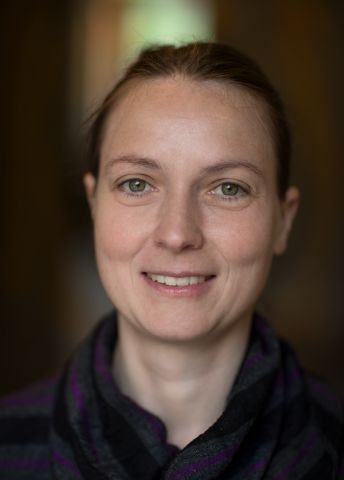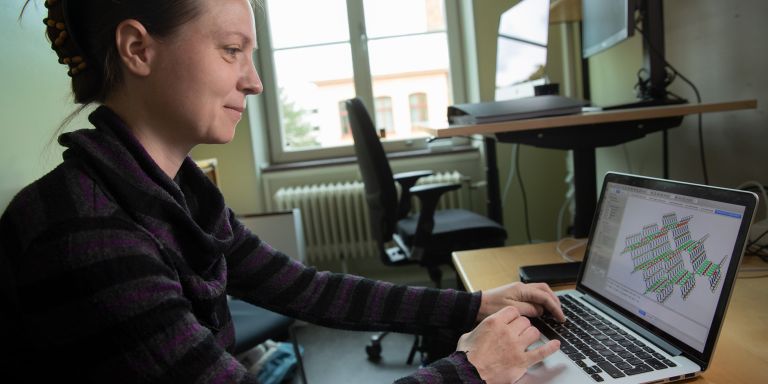
Maria Hermanns
PhD Theoretical Physics
Wallenberg Academy Fellow 2017
Institution:
Stockholm University
Research:
Theoretical condensed matter physics


Wallenberg Academy Fellow 2017
Institution:
Stockholm University
Research:
Theoretical condensed matter physics
“Previously, I only used pen and paper in my research. Now I’ve started using a computer for some calculations and to create visual representations,” Hermanns explains.
She opens an image on her computer. Colorful small balls illustrate the position of various elements in a crystal structure. It is a model of one of the physical systems that Hermanns is studying as part of her research at Nordita – the Nordic Institute for Theoretical Physics, and the Department of Physics at Stockholm University.
The images help Hermanns to gain a better understanding of the systems she is working with, whose structures and properties are typically complicated, but that may pave the way for new exotic materials.
Hermanns is a theoretical physicist. Her research involves studying “topologically ordered systems”. Topology is a branch of mathematics that describes objects on the basis of their global structure, and in which properties can only change in stages. For instance, a sphere and a bowl have the same topology. They have no holes and can be reshaped into each other without being torn apart. A donut, on the other hand, has a hole, and belongs to a different topological class.
But topology has also been found to be an effective tool in physics. Materials that can be described in topological terms may display unusual material states with interesting properties. “Topological insulators” have been discovered, for example; these are materials whose topological properties render them conductive on their surface, but not in their interior.
Hermanns’ project involves studying topological states with the help of theoretical calculations, although she is also in contact with experimental researchers.
“We consider what is theoretically possible, and use that as a basis for suggesting materials that harbor these states, and could be made experimentally. As yet there are only a few real systems that we know for sure are topologically ordered,” Hermanns says.
It is generally hoped that it will be possible to use materials of this kind in new generations of electronics and superconductors. Hermanns’ research includes a topological state called “quantum spin liquids”. One potential application of quantum spin liquids that sometimes is mentioned is to use them as building blocks for powerful quantum computers of the future. But Hermanns is more cautious about potential applications.
“That’s not what is driving my research. I think what I’m doing is interesting in itself. We’ll see where it leads. And I don’t think quantum spin liquids can be used for anything. They are rather elusive. Even decades after their theoretical prediction, we still don’t have an experimental system that we can definitely say is a quantum spin liquid.”
“This grant will enable me to put together my own research team. My research contribution will be richer if it involves more people. The funding also gives me a secure basis for venturing to address questions that are of great interest, but that I’m not sure can be answered.”
One of Hermann’s specialties is the study of topological material phases in three dimensions, i.e. not just on flat surfaces. Three dimensions offer greater potential than two – a 3D system might contain several types of quantum spin liquids, for example. But at present we know little about these systems. She elaborates:
“I want to improve our understanding of what might happen in three dimensions. For instance, I’m studying the effects at the boundaries of three-dimensional systems – what happens if we join two systems together or introduce impurities in the material.”
Hermanns’ research contributes to our theoretical knowledge, which can then be tested experimentally in real 3D materials.
“Yes, hopefully – but in practical terms the most promising materials are still two-dimensional. But we do have some interesting 3D candidates.”
Being chosen as a Wallenberg Academy Fellow brings Hermanns back to Stockholm. She studied for her master’s in physics at KTH Royal Institute of Technology and for her doctorate at Stockholm University. She then worked as a postdoc at Princeton in the U.S. and at Cologne University in Germany. Most recently she spent a year researching at the University of Gothenburg.
Now she is slowly putting together her own research team at Stockholm University. She thinks that one postdoc and two PhD students will fill the bill.
“Many more than that and I won’t have time to do my own calculations, which is something I would miss. I like doing calculations, and I want to have the time for them.”
Hermanns was born and raised in Germany. At school she enjoyed science of all kinds, and it was by no means a given that she would specialize in physics.
“I thought that mathematics was too dry and chemistry too applied, so I chose physics, which seemed to be somewhere in between. I chose physics by chance, and I liked it.”
Text Sara Nilsson
Translation Maxwell Arding
Photo Magnus Bergström